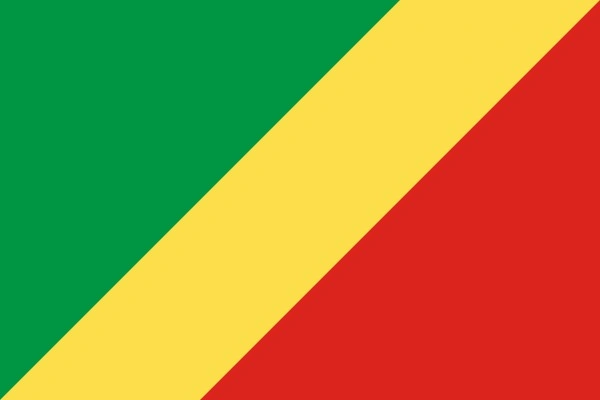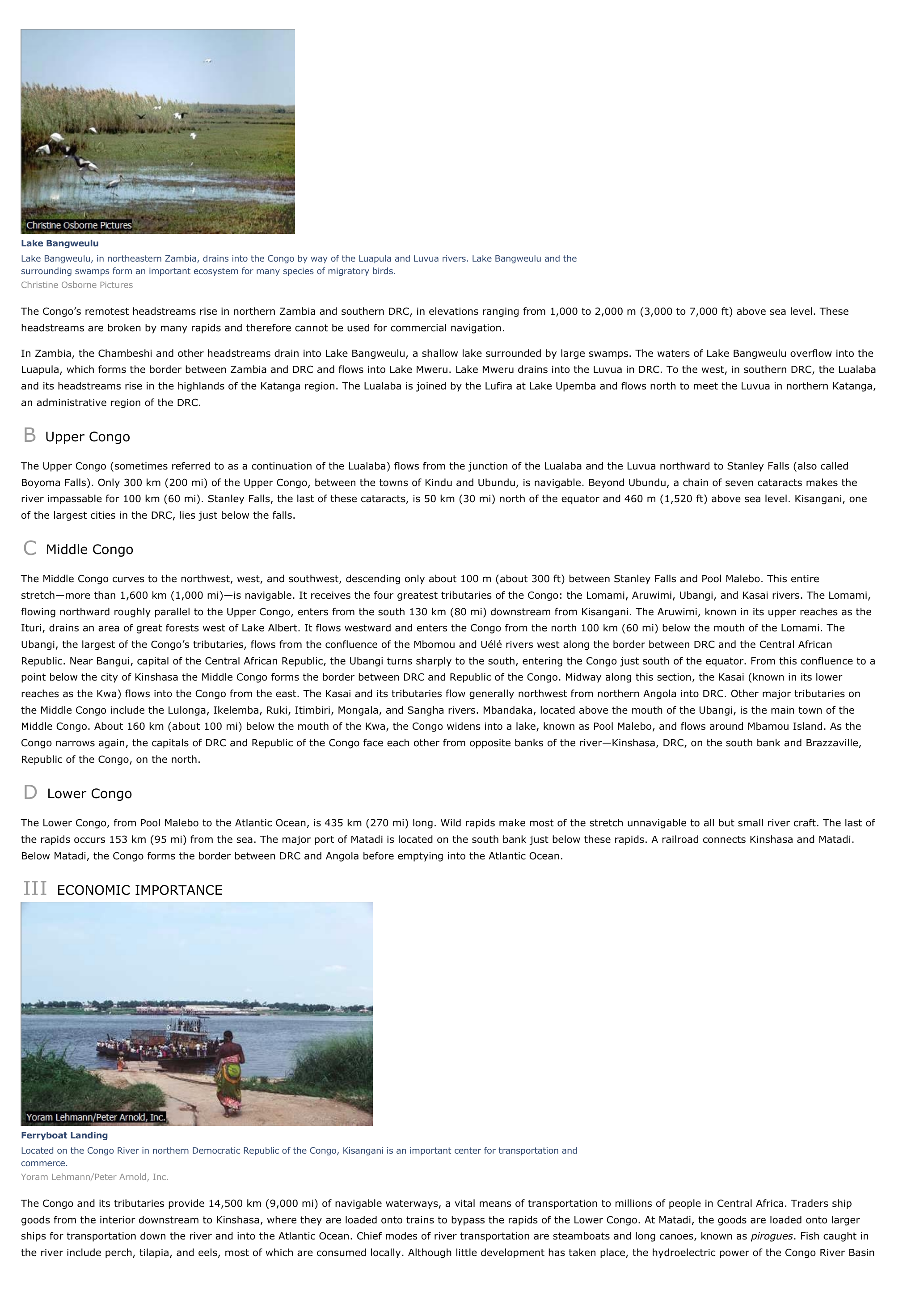Congo (river) - geography.
Publié le 26/05/2013
Extrait du document


«
Lake BangweuluLake Bangweulu, in northeastern Zambia, drains into the Congo by way of the Luapula and Luvua rivers.
Lake Bangweulu and thesurrounding swamps form an important ecosystem for many species of migratory birds.Christine Osborne Pictures
The Congo’s remotest headstreams rise in northern Zambia and southern DRC, in elevations ranging from 1,000 to 2,000 m (3,000 to 7,000 ft) above sea level.
Theseheadstreams are broken by many rapids and therefore cannot be used for commercial navigation.
In Zambia, the Chambeshi and other headstreams drain into Lake Bangweulu, a shallow lake surrounded by large swamps.
The waters of Lake Bangweulu overflow into theLuapula, which forms the border between Zambia and DRC and flows into Lake Mweru.
Lake Mweru drains into the Luvua in DRC.
To the west, in southern DRC, the Lualabaand its headstreams rise in the highlands of the Katanga region.
The Lualaba is joined by the Lufira at Lake Upemba and flows north to meet the Luvua in northern Katanga,an administrative region of the DRC.
B Upper Congo
The Upper Congo (sometimes referred to as a continuation of the Lualaba) flows from the junction of the Lualaba and the Luvua northward to Stanley Falls (also calledBoyoma Falls).
Only 300 km (200 mi) of the Upper Congo, between the towns of Kindu and Ubundu, is navigable.
Beyond Ubundu, a chain of seven cataracts makes theriver impassable for 100 km (60 mi).
Stanley Falls, the last of these cataracts, is 50 km (30 mi) north of the equator and 460 m (1,520 ft) above sea level.
Kisangani, oneof the largest cities in the DRC, lies just below the falls.
C Middle Congo
The Middle Congo curves to the northwest, west, and southwest, descending only about 100 m (about 300 ft) between Stanley Falls and Pool Malebo.
This entirestretch—more than 1,600 km (1,000 mi)—is navigable.
It receives the four greatest tributaries of the Congo: the Lomami, Aruwimi, Ubangi, and Kasai rivers.
The Lomami,flowing northward roughly parallel to the Upper Congo, enters from the south 130 km (80 mi) downstream from Kisangani.
The Aruwimi, known in its upper reaches as theIturi, drains an area of great forests west of Lake Albert.
It flows westward and enters the Congo from the north 100 km (60 mi) below the mouth of the Lomami.
TheUbangi, the largest of the Congo’s tributaries, flows from the confluence of the Mbomou and Uélé rivers west along the border between DRC and the Central AfricanRepublic.
Near Bangui, capital of the Central African Republic, the Ubangi turns sharply to the south, entering the Congo just south of the equator.
From this confluence to apoint below the city of Kinshasa the Middle Congo forms the border between DRC and Republic of the Congo.
Midway along this section, the Kasai (known in its lowerreaches as the Kwa) flows into the Congo from the east.
The Kasai and its tributaries flow generally northwest from northern Angola into DRC.
Other major tributaries onthe Middle Congo include the Lulonga, Ikelemba, Ruki, Itimbiri, Mongala, and Sangha rivers.
Mbandaka, located above the mouth of the Ubangi, is the main town of theMiddle Congo.
About 160 km (about 100 mi) below the mouth of the Kwa, the Congo widens into a lake, known as Pool Malebo, and flows around Mbamou Island.
As theCongo narrows again, the capitals of DRC and Republic of the Congo face each other from opposite banks of the river—Kinshasa, DRC, on the south bank and Brazzaville,Republic of the Congo, on the north.
D Lower Congo
The Lower Congo, from Pool Malebo to the Atlantic Ocean, is 435 km (270 mi) long.
Wild rapids make most of the stretch unnavigable to all but small river craft.
The last ofthe rapids occurs 153 km (95 mi) from the sea.
The major port of Matadi is located on the south bank just below these rapids.
A railroad connects Kinshasa and Matadi.Below Matadi, the Congo forms the border between DRC and Angola before emptying into the Atlantic Ocean.
III ECONOMIC IMPORTANCE
Ferryboat LandingLocated on the Congo River in northern Democratic Republic of the Congo, Kisangani is an important center for transportation andcommerce.Yoram Lehmann/Peter Arnold, Inc.
The Congo and its tributaries provide 14,500 km (9,000 mi) of navigable waterways, a vital means of transportation to millions of people in Central Africa.
Traders shipgoods from the interior downstream to Kinshasa, where they are loaded onto trains to bypass the rapids of the Lower Congo.
At Matadi, the goods are loaded onto largerships for transportation down the river and into the Atlantic Ocean.
Chief modes of river transportation are steamboats and long canoes, known as pirogues .
Fish caught in the river include perch, tilapia, and eels, most of which are consumed locally.
Although little development has taken place, the hydroelectric power of the Congo River Basin.
»
↓↓↓ APERÇU DU DOCUMENT ↓↓↓
Liens utiles
- Congo (river) - Geography.
- St. Lawrence (river) - Geography. I INTRODUCTION St. Lawrence (river) (French Saint-Laurent), river
- Amazon (river) - Geography.
- Colorado (river, North America) - Geography.
- Mississippi (river) - Geography.

































